Abstract
Natural killer (NK) cells take up chylomicrons (CM), very low density (VLDL), low density (LDL), high density (HDL) and acetyl-modified low density (AcLDL) lipoproteins through different receptors, VLDL being the lipoprotein with the highest uptake and HDL the lowest. The uptake of LDL can be selectively blocked by the anti-LDL receptor, which does not affect the uptake of CM, VLDL, HDL and AcLDL. Although the uptake of lipoproteins assessed by flow cytometry using DiI is not very high, the lipoproteins are able to induce an increase in proliferative responses, VLDL, AcLDL and HDL being the most important ones with 12- and 17-fold increments, respectively. CM, VLDL and LDL at low concentrations increase NK cytotoxic activity, while HDL and AcLDL inhibit, in a dose-dependent fashion, the killing of NK cells against K562. These results suggest the presence of four different receptors that are responsible for the cytotoxic and proliferative responses observed.
Full text
PDF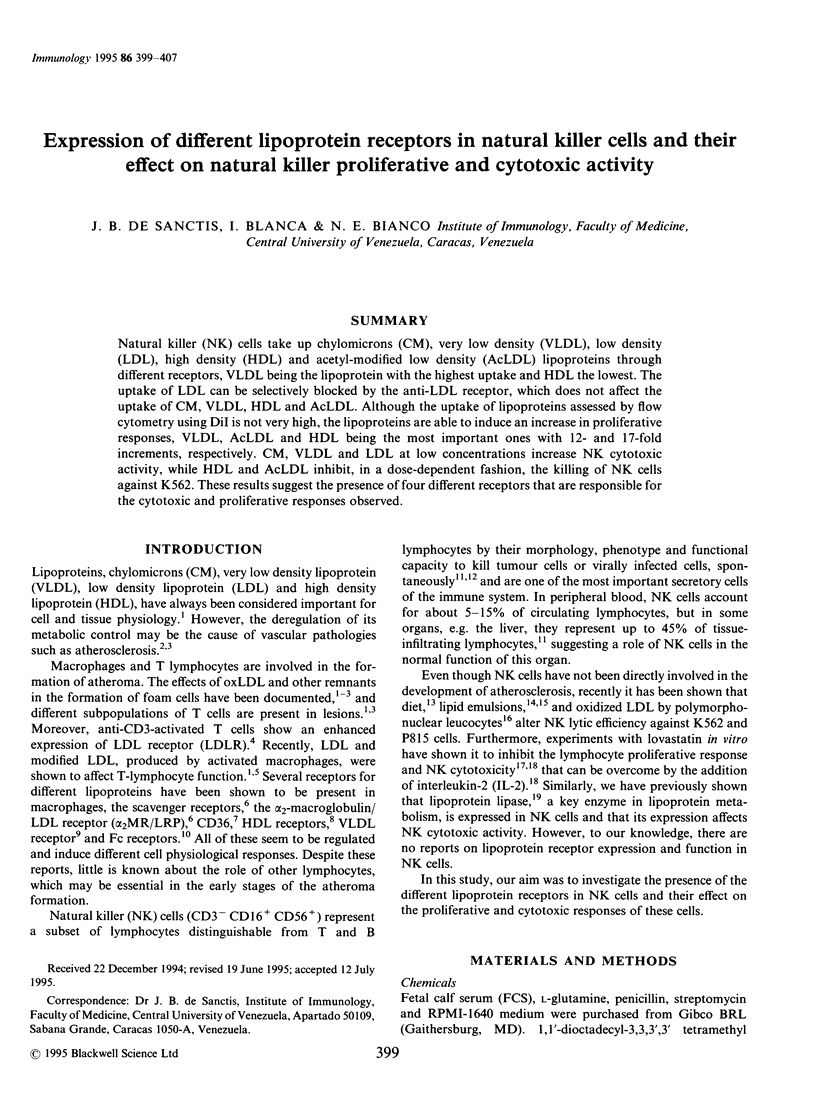
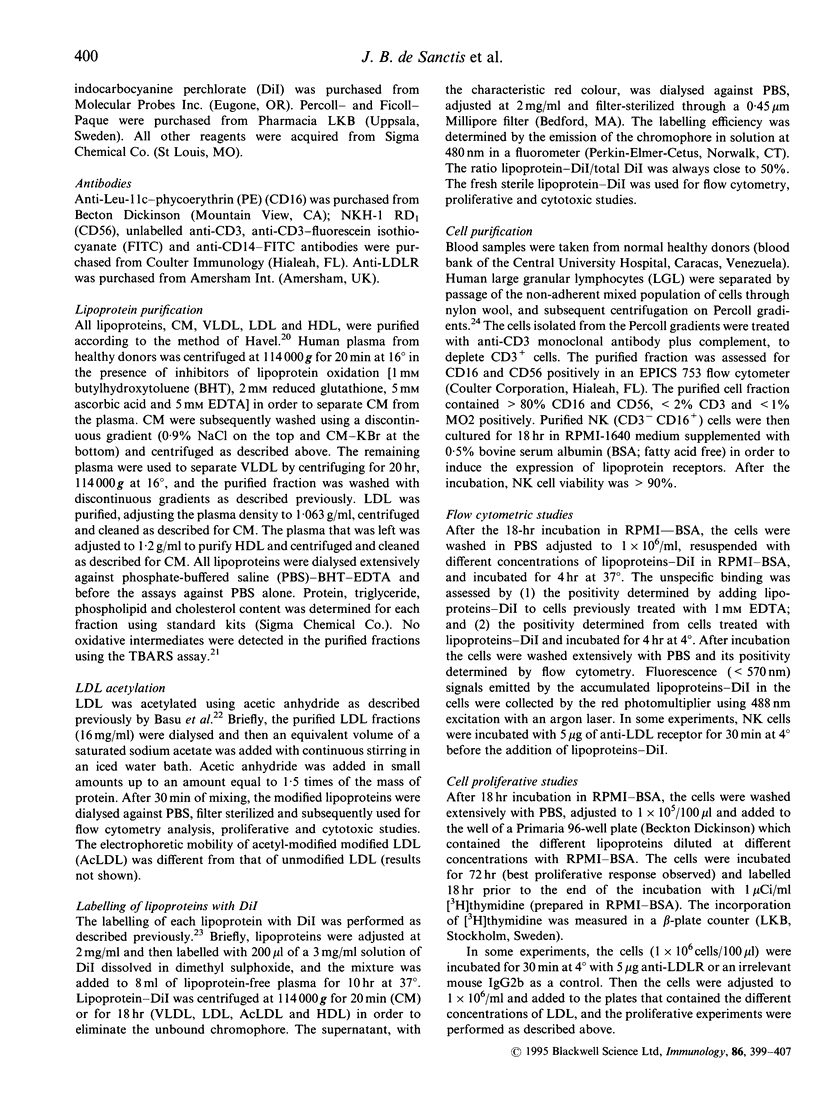
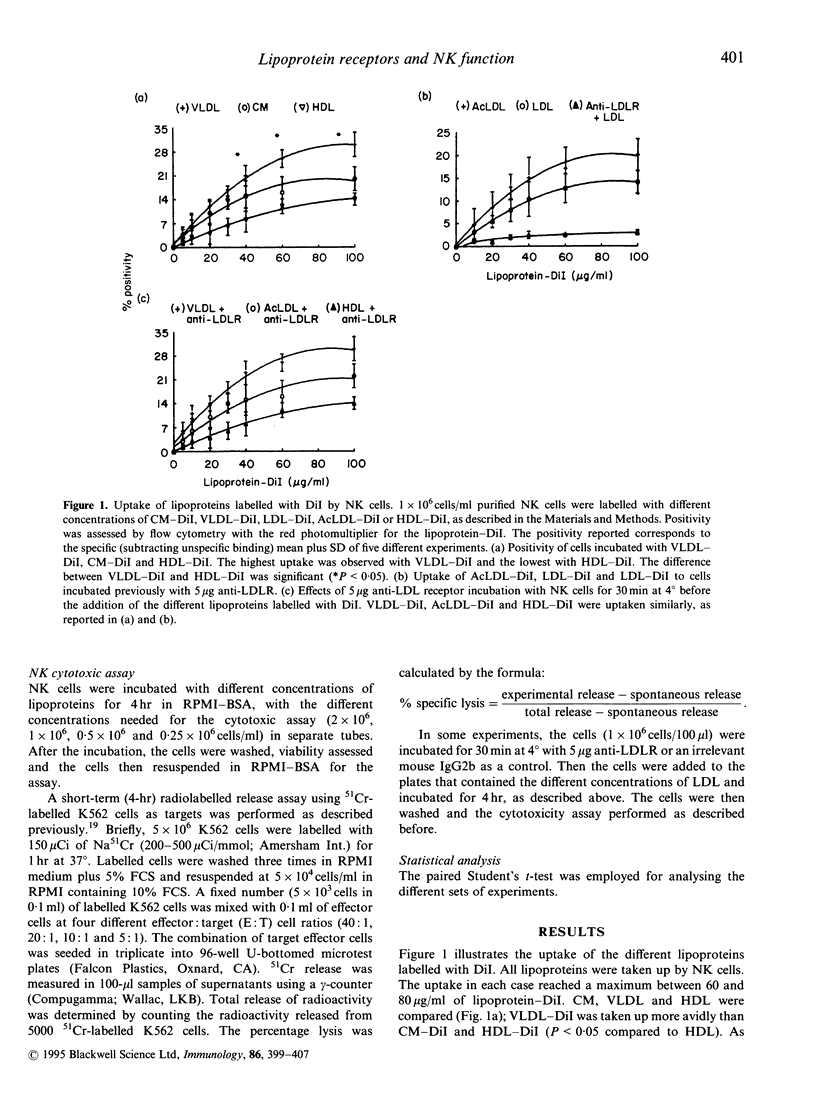
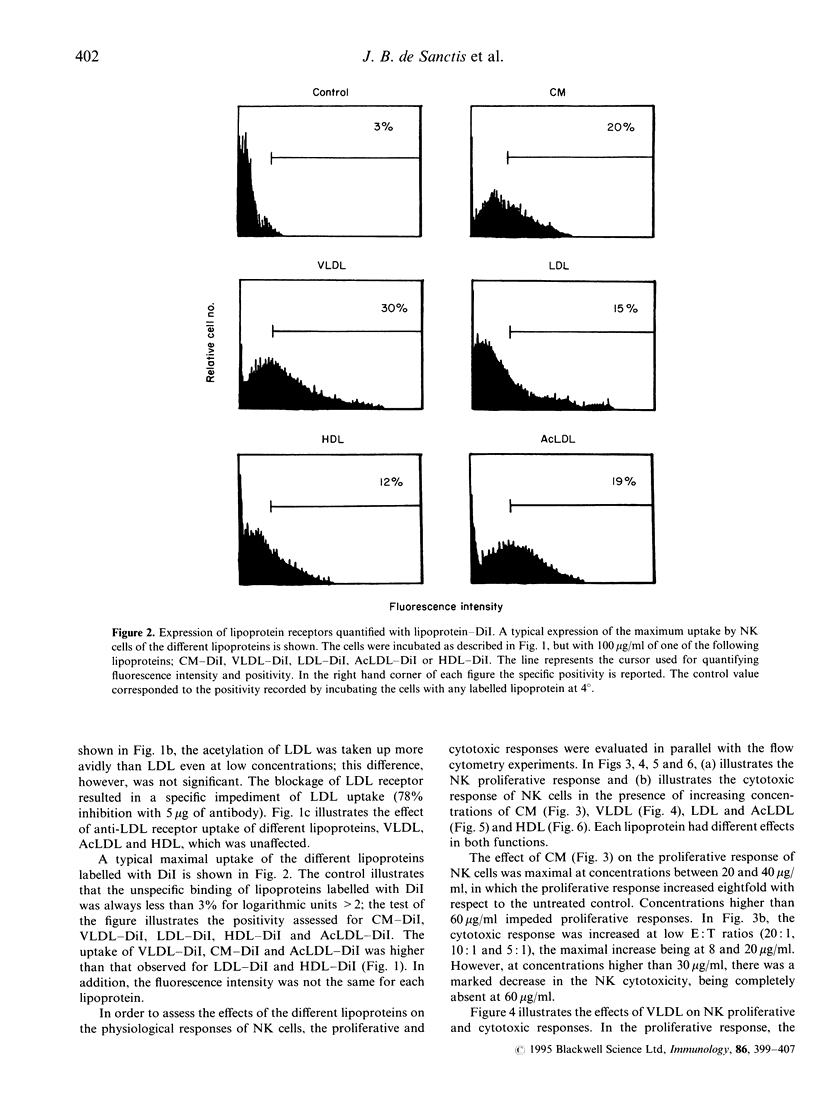
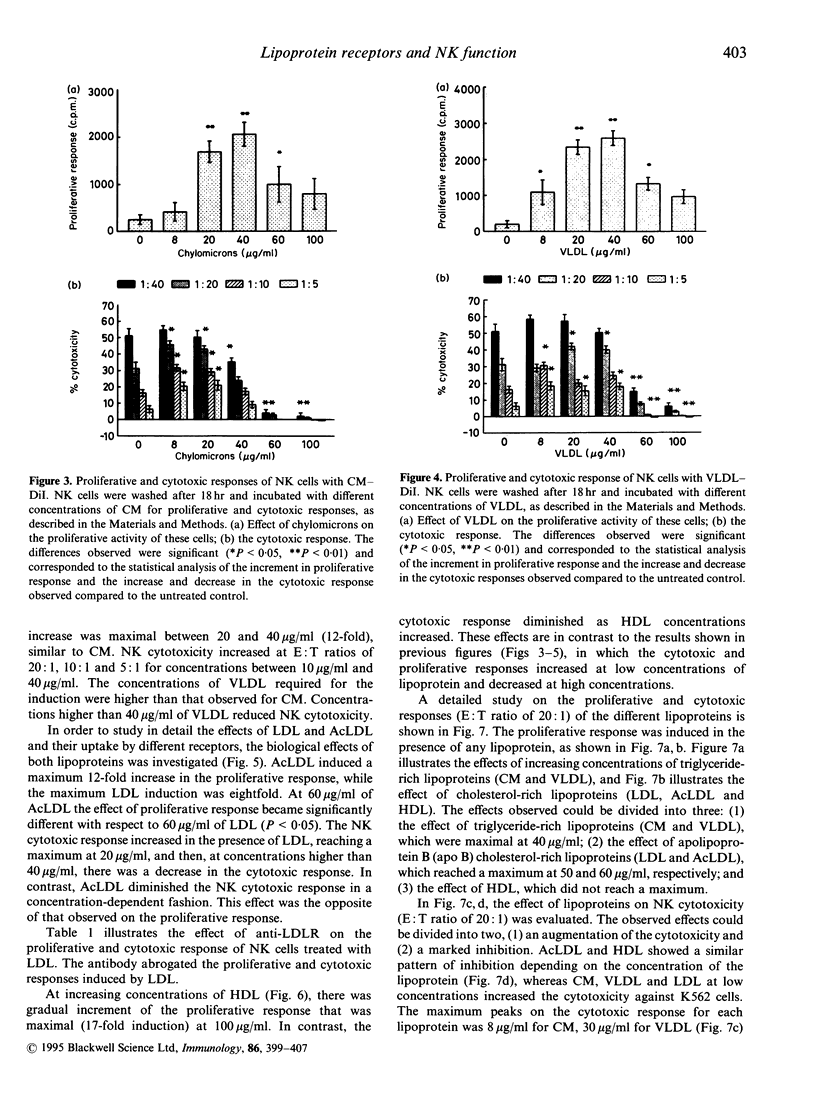
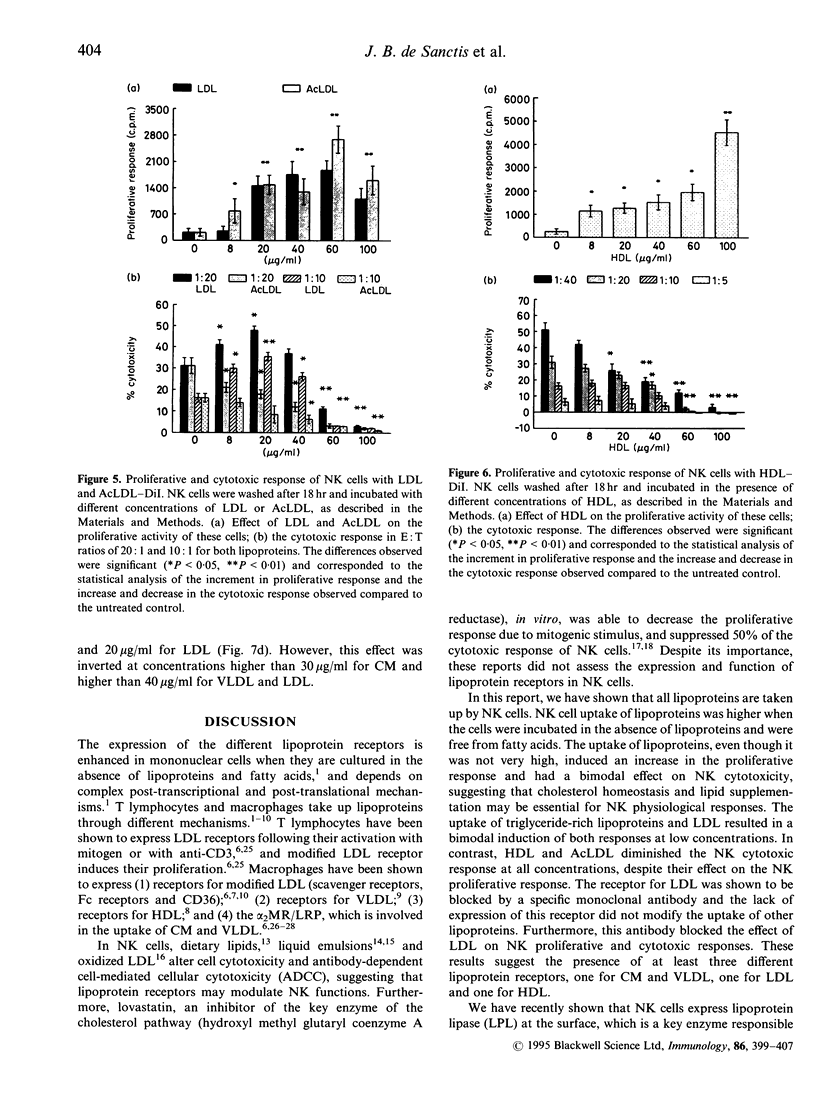
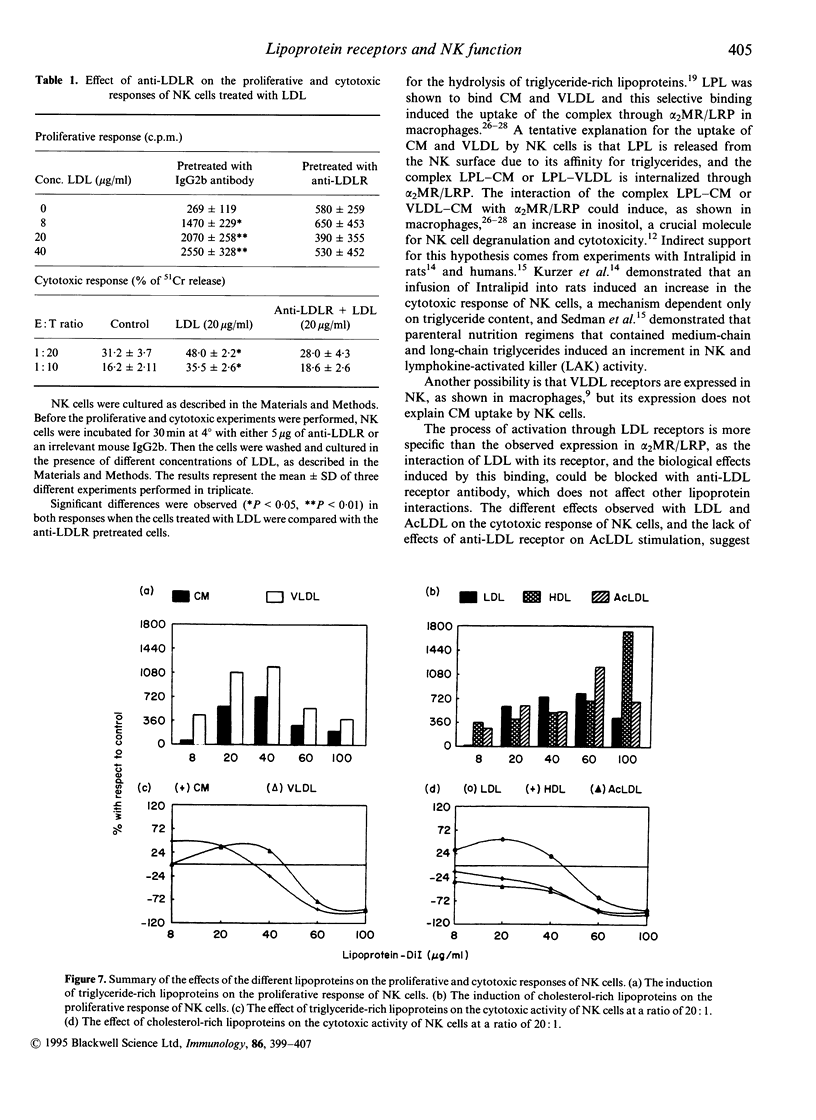
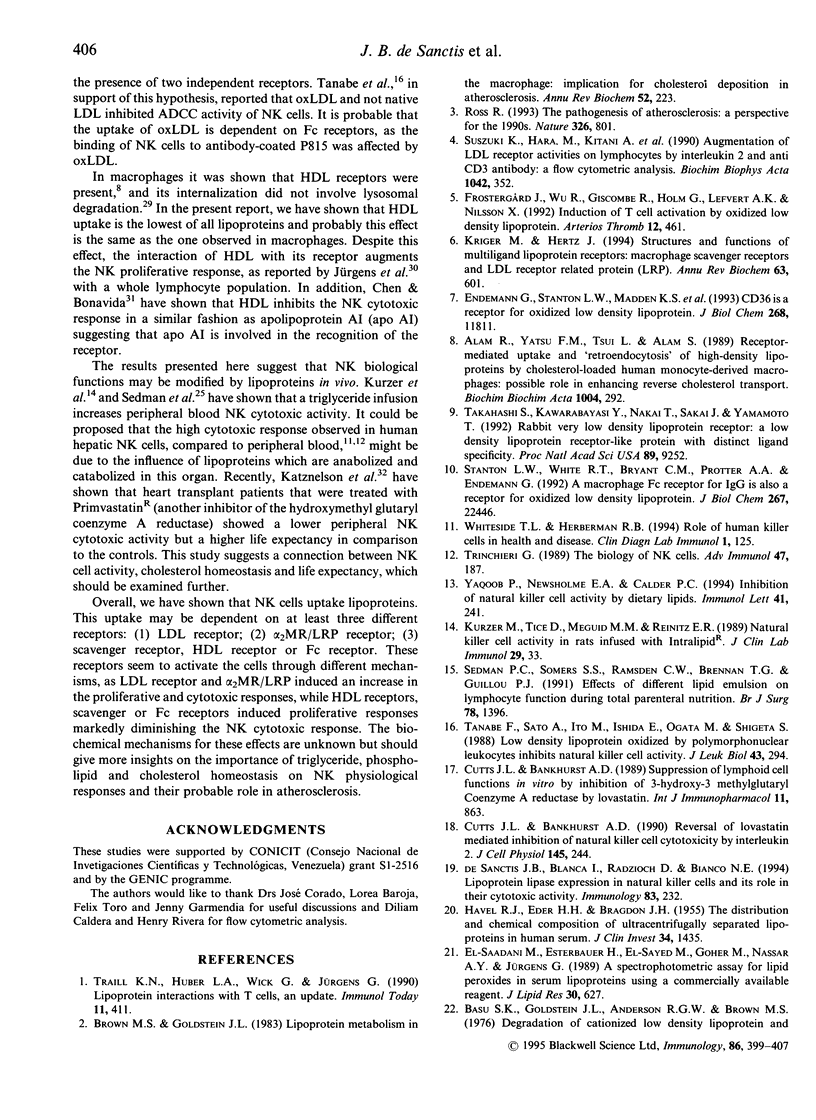
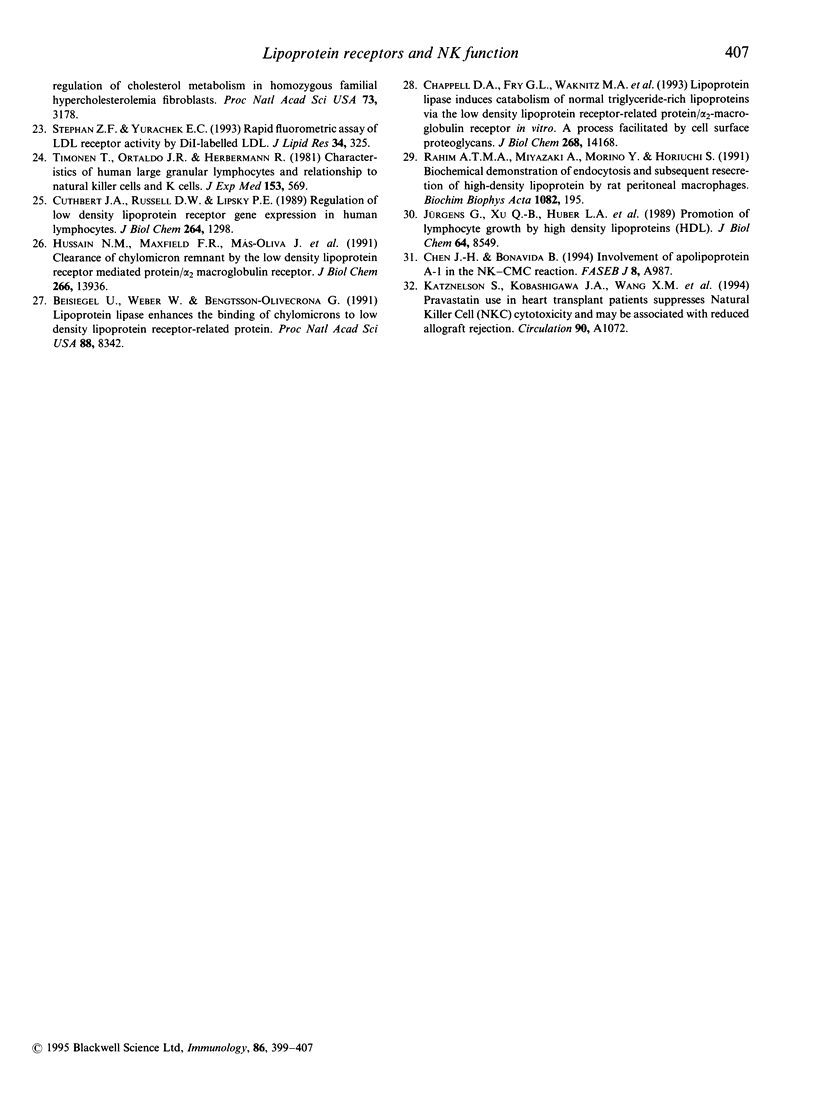
Selected References
These references are in PubMed. This may not be the complete list of references from this article.
- Alam R., Yatsu F. M., Tsui L., Alam S. Receptor-mediated uptake and 'retroendocytosis' of high-density lipoproteins by cholesterol-loaded human monocyte-derived macrophages: possible role in enhancing reverse cholesterol transport. Biochim Biophys Acta. 1989 Aug 22;1004(3):292–299. doi: 10.1016/0005-2760(89)90076-3. [DOI] [PubMed] [Google Scholar]
- Beisiegel U., Weber W., Bengtsson-Olivecrona G. Lipoprotein lipase enhances the binding of chylomicrons to low density lipoprotein receptor-related protein. Proc Natl Acad Sci U S A. 1991 Oct 1;88(19):8342–8346. doi: 10.1073/pnas.88.19.8342. [DOI] [PMC free article] [PubMed] [Google Scholar]
- Brown M. S., Goldstein J. L. Lipoprotein metabolism in the macrophage: implications for cholesterol deposition in atherosclerosis. Annu Rev Biochem. 1983;52:223–261. doi: 10.1146/annurev.bi.52.070183.001255. [DOI] [PubMed] [Google Scholar]
- Chappell D. A., Fry G. L., Waknitz M. A., Muhonen L. E., Pladet M. W., Iverius P. H., Strickland D. K. Lipoprotein lipase induces catabolism of normal triglyceride-rich lipoproteins via the low density lipoprotein receptor-related protein/alpha 2-macroglobulin receptor in vitro. A process facilitated by cell-surface proteoglycans. J Biol Chem. 1993 Jul 5;268(19):14168–14175. [PubMed] [Google Scholar]
- Cuthbert J. A., Russell D. W., Lipsky P. E. Regulation of low density lipoprotein receptor gene expression in human lymphocytes. J Biol Chem. 1989 Jan 15;264(2):1298–1304. [PubMed] [Google Scholar]
- Cutts J. L., Bankhurst A. D. Reversal of lovastatin-mediated inhibition of natural killer cell cytotoxicity by interleukin 2. J Cell Physiol. 1990 Nov;145(2):244–252. doi: 10.1002/jcp.1041450208. [DOI] [PubMed] [Google Scholar]
- Cutts J. L., Bankhurst A. D. Suppression of lymphoid cell function in vitro by inhibition of 3-hydroxy-3-methylglutaryl coenzyme A reductase by lovastatin. Int J Immunopharmacol. 1989;11(8):863–869. doi: 10.1016/0192-0561(89)90107-0. [DOI] [PubMed] [Google Scholar]
- Endemann G., Stanton L. W., Madden K. S., Bryant C. M., White R. T., Protter A. A. CD36 is a receptor for oxidized low density lipoprotein. J Biol Chem. 1993 Jun 5;268(16):11811–11816. [PubMed] [Google Scholar]
- Frostegård J., Wu R., Giscombe R., Holm G., Lefvert A. K., Nilsson J. Induction of T-cell activation by oxidized low density lipoprotein. Arterioscler Thromb. 1992 Apr;12(4):461–467. doi: 10.1161/01.atv.12.4.461. [DOI] [PubMed] [Google Scholar]
- Hussain M. M., Maxfield F. R., Más-Oliva J., Tabas I., Ji Z. S., Innerarity T. L., Mahley R. W. Clearance of chylomicron remnants by the low density lipoprotein receptor-related protein/alpha 2-macroglobulin receptor. J Biol Chem. 1991 Jul 25;266(21):13936–13940. [PubMed] [Google Scholar]
- Jürgens G., Xu Q. B., Huber L. A., Böck G., Howanietz H., Wick G., Traill K. N. Promotion of lymphocyte growth by high density lipoproteins (HDL). Physiological significance of the HDL binding site. J Biol Chem. 1989 May 25;264(15):8549–8556. [PubMed] [Google Scholar]
- Krieger M., Herz J. Structures and functions of multiligand lipoprotein receptors: macrophage scavenger receptors and LDL receptor-related protein (LRP). Annu Rev Biochem. 1994;63:601–637. doi: 10.1146/annurev.bi.63.070194.003125. [DOI] [PubMed] [Google Scholar]
- Kurzer M., Tice D., Meguid M. M., Reinitz E. R. Natural killer cell activity in rats infused with Intralipid. J Clin Lab Immunol. 1989 May;29(1):33–35. [PubMed] [Google Scholar]
- Rahim A. T., Miyazaki A., Morino Y., Horiuchi S. Biochemical demonstration of endocytosis and subsequent resecretion of high-density lipoprotein by rat peritoneal macrophages. Biochim Biophys Acta. 1991 Mar 12;1082(2):195–203. doi: 10.1016/0005-2760(91)90194-m. [DOI] [PubMed] [Google Scholar]
- Ross R. The pathogenesis of atherosclerosis: a perspective for the 1990s. Nature. 1993 Apr 29;362(6423):801–809. doi: 10.1038/362801a0. [DOI] [PubMed] [Google Scholar]
- Sedman P. C., Somers S. S., Ramsden C. W., Brennan T. G., Guillou P. J. Effects of different lipid emulsions on lymphocyte function during total parenteral nutrition. Br J Surg. 1991 Nov;78(11):1396–1399. doi: 10.1002/bjs.1800781142. [DOI] [PubMed] [Google Scholar]
- Stanton L. W., White R. T., Bryant C. M., Protter A. A., Endemann G. A macrophage Fc receptor for IgG is also a receptor for oxidized low density lipoprotein. J Biol Chem. 1992 Nov 5;267(31):22446–22451. [PubMed] [Google Scholar]
- Stephan Z. F., Yurachek E. C. Rapid fluorometric assay of LDL receptor activity by DiI-labeled LDL. J Lipid Res. 1993 Feb;34(2):325–330. [PubMed] [Google Scholar]
- Suzuki K., Hara M., Kitani A., Harigai M., Norioka K., Kondo K., Hirata F., Sakata N., Kawakami M., Kawagoe M. Augmentation of LDL receptor activities on lymphocytes by interleukin-2 and anti-CD3 antibody: a flow cytometric analysis. Biochim Biophys Acta. 1990 Feb 23;1042(3):352–358. doi: 10.1016/0005-2760(90)90164-s. [DOI] [PubMed] [Google Scholar]
- Takahashi S., Kawarabayasi Y., Nakai T., Sakai J., Yamamoto T. Rabbit very low density lipoprotein receptor: a low density lipoprotein receptor-like protein with distinct ligand specificity. Proc Natl Acad Sci U S A. 1992 Oct 1;89(19):9252–9256. doi: 10.1073/pnas.89.19.9252. [DOI] [PMC free article] [PubMed] [Google Scholar]
- Timonen T., Ortaldo J. R., Herberman R. B. Characteristics of human large granular lymphocytes and relationship to natural killer and K cells. J Exp Med. 1981 Mar 1;153(3):569–582. doi: 10.1084/jem.153.3.569. [DOI] [PMC free article] [PubMed] [Google Scholar]
- Traill K. N., Huber L. A., Wick G., Jürgens G. Lipoprotein interactions with T cells: an update. Immunol Today. 1990 Nov;11(11):411–417. doi: 10.1016/0167-5699(90)90161-2. [DOI] [PubMed] [Google Scholar]
- Trinchieri G. Biology of natural killer cells. Adv Immunol. 1989;47:187–376. doi: 10.1016/S0065-2776(08)60664-1. [DOI] [PMC free article] [PubMed] [Google Scholar]
- Whiteside T. L., Herberman R. B. Role of human natural killer cells in health and disease. Clin Diagn Lab Immunol. 1994 Mar;1(2):125–133. doi: 10.1128/cdli.1.2.125-133.1994. [DOI] [PMC free article] [PubMed] [Google Scholar]
- Yaqoob P., Newsholme E. A., Calder P. C. Inhibition of natural killer cell activity by dietary lipids. Immunol Lett. 1994 Jul;41(2-3):241–247. doi: 10.1016/0165-2478(94)90140-6. [DOI] [PubMed] [Google Scholar]
- de Sanctis J. B., Blanca I., Radzioch D., Bianco N. E. Lipoprotein lipase expression in natural killer cells and its role in their cytotoxic activity. Immunology. 1994 Oct;83(2):232–239. [PMC free article] [PubMed] [Google Scholar]
- el-Saadani M., Esterbauer H., el-Sayed M., Goher M., Nassar A. Y., Jürgens G. A spectrophotometric assay for lipid peroxides in serum lipoproteins using a commercially available reagent. J Lipid Res. 1989 Apr;30(4):627–630. [PubMed] [Google Scholar]


